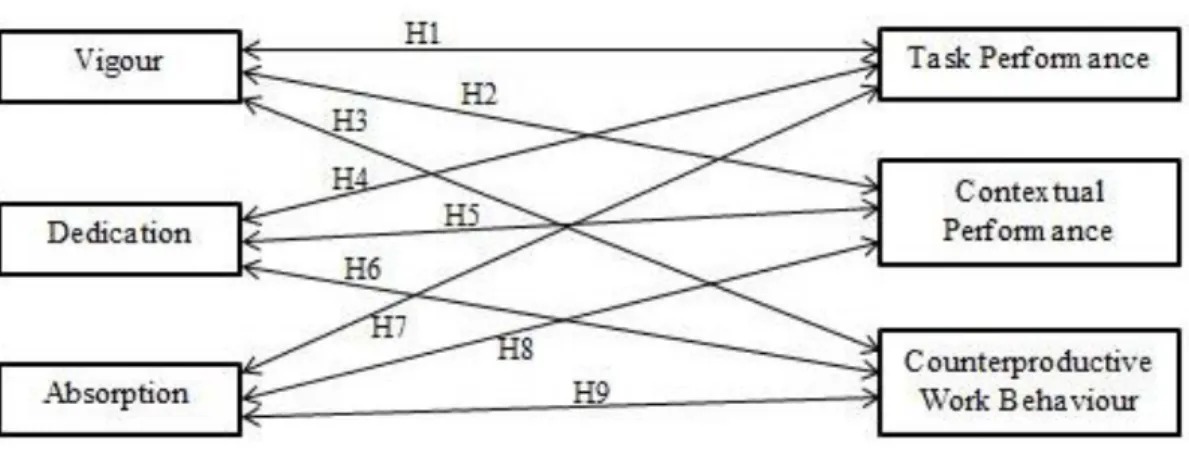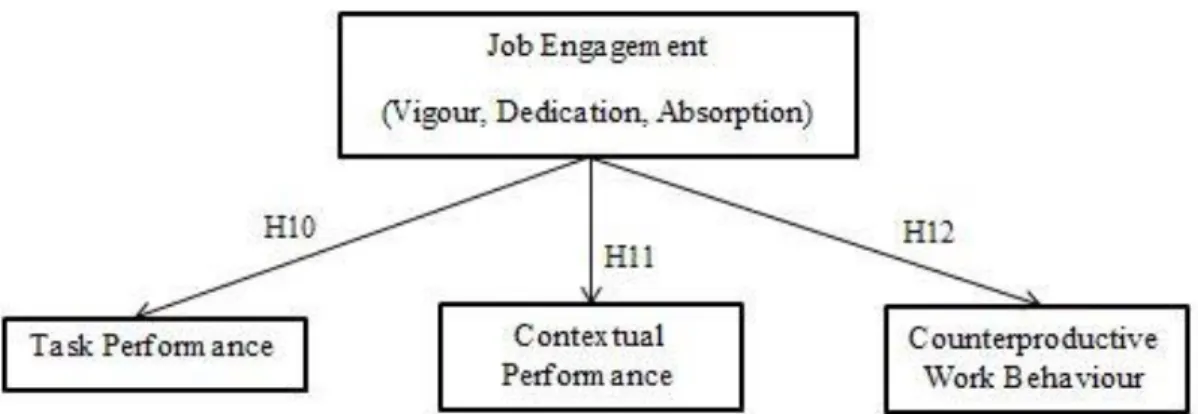This study aimed to study the relationship between dimensions of work engagement (vigor, commitment, absorption) and individual work performance (task performance, contextual performance, counterproductive work behavior (CWB)) among academic staff in higher education institutions. Rodney Sin Ming Keen (ID No: 20AAM03715) has completed this dissertation entitled ―Work Engagement and Individual Work Performance among Academic Staff in Malaysian Higher Education Institutions‖ under the supervision of Dr.

Research Background
IWP consists of three dimensions which are task performance, contextual performance and counterproductive work behavior (Koopmans et al., 2012). CWB is defined as a type of negative and deviant employee behavior with the aim of harming organizations and their members (Rana et al., 2019).
Overview of Higher Education Sector in Malaysia
The present study will interpret each dimension of IWP to measure the academic staff's performance. The gap between work demand and work resources of the academic staff will lead to challenges and negative impacts on the IWP of the academic staff (Sia & Adamu, 2020).
Problem Statement
Regarding the gap in the literature, previous researchers revealed that most previous studies on the relationship between job engagement and IWP had overlooked the Malaysian samples (Kim et al., 2012). The previous studies were mainly conducted in the United States (Halbesleben & Wheeler, 2008), Great Britain (Shantz et al., 2013), the Netherlands (Gorgievski et al., 2010), Australia.
Significance of the Study
Most of the previous studies investigated the relationship between the dimensions of work engagement and IWP among non-academics. In addition, there is a lack of understanding of the relationship between work engagement and IWP in the local context.
Research Objectives
Research Questions
Hypotheses
Does job engagement (strength, commitment, absorption) predict counterproductive work behavior among academic staff in Malaysia? H12: Work engagement (vigour, dedication, absorption) can predict counterproductive work behavior among academic staff in Malaysia.
Conceptual Definition and Operational Definition
On the other hand, counterproductive work behavior (CWB) refers to any action that harms the well-being of the organization and its members (Koopmans et al., 2014). The questionnaire measures IWP based on three dimensions, which are task performance, contextual performance, and counterproductive work behavior.
Demographic Variable
Vigour and Task Performance
Halbesleben and Wheeler (2008) examined the relationship between work engagement and in-role performance in the United States. Gorgievski (2010) and colleagues investigated the relationship between work engagement and job performance among employed and self-employed workers in the Netherlands.
Vigour and Contextual Performance
The previous study examined the relationship between perceived organizational support for strength used (POSSU), work engagement and contextual performance (Meyers et al., 2019). The results showed that work engagement and contextual performance are positively correlated. 2019) suggests that employees who feel more vital are more likely to take on activities that are not dictated by their position.
Vigour and Counterproductive Work Behaviour
The UWES-9 developed by Scahufeli and Bakker (2003) and the contextual performance subscale of the IWPQ developed by Koopmans et al. 2014) was used to measure job engagement and contextual performance. The previous finding is consistent with that of Rana et al. 2019) found among IT workers in India.
Dedication and Task Performance
Roseline and Konya (2019) investigated the relationship between employee commitment and employee performance among shipping operators. Pearson's Product Moment Correlation Coefficient analysis supported a strong relationship between employee commitment and overall productivity, growth and survival.
Dedication and Contextual Performance
The finding supported the significant relationship between dedication and contextual performance suggested by this study. In their study, work engagement was characterized by vigor, dedication and absorption and was measured using the UWES-9 scale.
Dedication and Counterproductive Work Behaviour
Their study investigated the role of work-related affect in the relationship between the job-resource-demand pattern and CWB among employees of a public administration agency in central Italy. Further analysis revealed that commitment contributed the most to the relationship between work engagement and CWB compared to vigor and absorption. 2017) investigated the relationship between work engagement and multiple dimensions of job performance and the mediating role of open-mindedness.
Absorption and Task Performance
Teachers' job performance was measured in two dimensions: task performance and contextual performance. In 2019, Rana and colleagues investigated the relationship between engagement (strength, dedication, absorption) on IWP (task performance, contextual performance, and CWB).
Absorption and Contextual Performance
Employee engagement was characterized by strength, commitment, and commitment and measured using the UWES-17 (Schaufeli & Bakker, 2003). The outcome of the 6- and 12-month follow-up periods showed no significant effects of the intervention on absorption, while a significantly lower contextual performance was found. The results indicated that the relationship between absorption and contextual performance may be inconclusive compared to other studies.
Absorption and Counterproductive Work Behaviour
In 2013, Fourie published his master's thesis findings on the relationship between the subsets of work engagement and the subsets of CWB. The outcome of intercorrelations between the selected dimensions demonstrated a non-significant relationship between absorption and power and the dimensions of CWB. The significant relationship between absorption and CWB is consistent with what other researchers have suggested in their study.
Research Gap
Rana's study also found that absorption serves as the strongest predictor of CWB compared to power and commitment. 2019) conducted a cross-sectional study among academic staff in Pakistan to investigate the relationship between employment and CWB. The results showed that work engagement, characterized by vigor, dedication, and commitment, was strongly and negatively related to CWB. Even some have been implemented in the field of education, and few have been implemented in higher education settings.
Theoretical Framework
These characteristics are conceptually similar to vigor, dedication and immersion in the dimensions of job engagement. These role performances can also be related to task performance, contextual performance, and CWB, supporting the research framework of this study. The findings contributed to developing a dynamic process model of engagement by proving that job engagement can predict long-term job performance. 2016), they suggested that role performance, organizational citizenship behavior and intention to quit are the key outcomes of personal commitment proposed by Kahn (1990).
Conceptual Framework
Research Design
Sampling Method
Thus, the inclusion criterion of the target group is that it is a full-time academic staff of public and private universities in Malaysia. These sample characteristics were filtered as desirable to collect data from academic staff from both public and private universities who share similar work experience. However, it cannot be denied that these criteria lead to a limitation of the current study to include only public and private universities, while overlooking the population of polytechnics, colleges, accredited training centers, language centers, etc.
Sample Size
Location
The researcher reached the potential sample by distributing a total of 3225 online surveys through their respective university emails.
Demographic Information
Procedures
The pilot study is also effective in identifying errors in instruments by ensuring the reliability of the instruments selected. For the present study, pilot study provided an opportunity to demonstrate the data collection procedure and to test for the scale reliability of the instruments. The internal consistency of the instruments was evaluated by analyzing whether the Cronbach alpha value is more than 0.7 (George & Mallery, 2003).
Instruments
The items are all positively worded; a higher sum of the scores indicates a higher work engagement. The Individual Work Performance Questionnaire (IWPQ) revised by Koopmans et al. 2014) was used to measure individual job performance. The dimensions of IWPQ possess a high construct validity and internal consistency with a person separation index of .81, .85 and .74 respectively (Koopmans et al., 2014).
Data Analysis
Reliability
Normality Assumptions
Since outliers can become an influential case, this study decided to remove outliers to increase the accuracy of the results.
Multiple Linear Regression (MLR) Assumptions
VI = Vigour, DE = Commitment, AB = Absorption, TP = Task Performance, CP = Contextual Performance, CWB = Counterproductive Work Behavior, M = Mean, SD = Standard Deviation. Dependent variable of Model 1 = Task Performance, Dependent variable of Model 2 = Contextual Performance, Dependent variable of Model 3 = CWB. In addition, the assumptions of linearity of residuals, residual normality and homoscedasticity were examined by generating the scatterplot of data.
Correlation
H4 There is a significant positive relationship between commitment and task performance among academic staff in Malaysia. H7 There is a significant positive relationship between absorption and task performance among academic staff in Malaysia. H8 There is a significant positive relationship between absorption and contextual performance among academic staff in Malaysia.
Hierarchical Multiple Linear Regression
Since the change in R2 of the second block is significant, work engagement can predict task performance, suggesting that H10 was supported. The HMLR was conducted to examine whether work engagement (nervousness, dedication, and commitment) could predict contextual performance. In addition, age, gender, education level, and marital status were found not to predict CWB after accounting for the effect of employment in the second block.
Introduction
Discussion
The present study revealed that academic staff dedication does not contribute to higher contextual performance. Besides that, the present study also found that academic staff dedication does not predict their CWB. Finally, the results of this study revealed that there is no prediction of CWB from the absorption of academic staff.
Implication
Therefore, the theory is suitable for explaining the relationship between job engagement and IWP among Malaysian academic staff. First, the present study suggested that gender has a significant moderating effect on the relationship between job engagement and task performance and contextual performance of academic staff. This study can also raise the awareness of academic staff about how their job engagement and IWP will be affected during the pandemic.
Limitations and Recommendations
Finally, one of the limitations is that the present study remains inconclusive regarding the relationship between work engagement and IWP. The current study did not capture important participant information, such as work pattern and year of work tenure. The inclusion of mediator or moderator may make more sense in explaining the inconsistency of the relationship between work engagement and IWP.
Conclusion
Work engagement transition among work couples: A closer look at the role of empathy. The relationship between work engagement and performance: A review of the empirical literature and a proposed research agenda. The Effects of Job Design on Work Engagement and Job Performance: A Study of Vietnamese Commercial Banks.
Evaluation of three dimensions of work engagement in social security organization of Yazd province, Iran. Work engagement and financial returns: A diary study of the role of work and personal resources.


